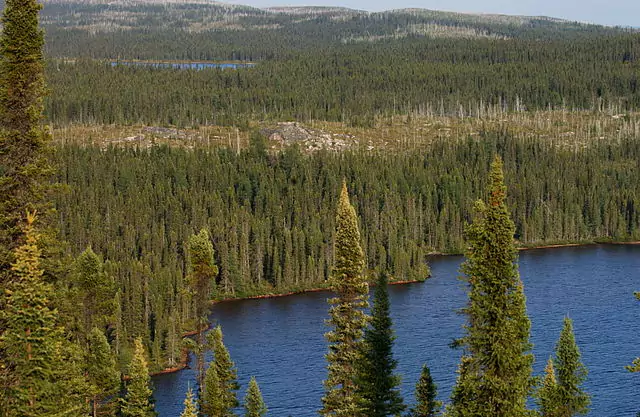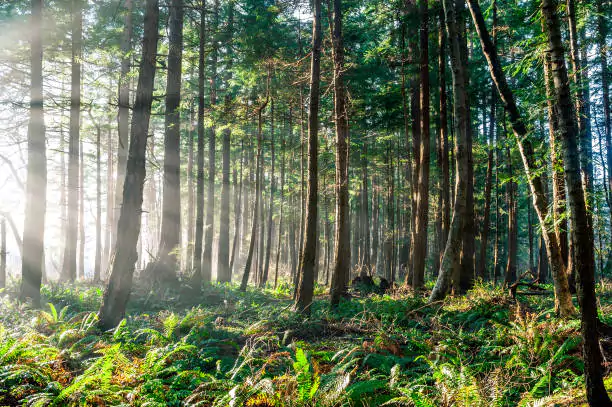Boreal Forest Threats and Conservation
What Are Boreal Forests?
Boreal forests, also called Taiga, are the largest biome on Earth, covering vast areas across the Northern Hemisphere. These forests are crucial for climate regulation, biodiversity conservation, and Indigenous livelihoods.
Key Features of Boreal Forests
- Geographic Location: Encircle the globe between 50° and 70° latitude in the Northern Hemisphere.
- Climate: Cold temperatures, long winters, and short summers with permafrost in many areas.
- Dominant Tree Species:
- Conifers: Spruce, fir, pine, larch.
- Deciduous trees: Birch, aspen, poplar.
- Soil Characteristics: Nutrient-poor, acidic soils with thick peat layers, permafrost, and slow decomposition rates.
Global Boreal Forest Distribution
Boreal forests cover ~13.7 million km² (~9% of Earth's land surface), with the largest portions in:
| Country/Region | Boreal Forest Coverage | % of Global Boreal Forests |
|---|---|---|
| Russia | 8 million km² | 60% (largest share) |
| Canada | 3.2 million km² | 30% |
| Scandinavia (Finland, Sweden, Norway) | 1.5 million km² | 10% |
| Alaska (USA) | ~0.7 million km² | Small but significant |
Fact: The boreal forest stores more carbon than all tropical rainforests combined, making it the largest terrestrial carbon sink on Earth.
The Importance of Boreal Forests in Global Climate Regulation
Boreal forests, also known as the Taiga, play a crucial role in maintaining global climate balance by acting as the largest terrestrial carbon sink. These vast forests store immense amounts of carbon, regulate global temperatures, and support biodiversity, making them a vital component of Earth’s climate system.
Boreal Forests as the World’s Largest Carbon Sink
Boreal forests are more effective at storing carbon than tropical forests due to their slow decomposition rates, carbon-rich peatlands, and extensive permafrost layers.
Why Are Boreal Forests Critical for Carbon Storage?
Massive Carbon Storage Capacity:
- Boreal forests store approximately 1,000 gigatons (Gt) of carbon, which accounts for 30% of the world’s terrestrial carbon reserves.
- This carbon is stored in:
- Trees & Biomass (40%)
- Soil & Peatlands (60%)
More Effective Carbon Sink than Tropical Rainforests:
- While the Amazon Rainforest absorbs carbon quickly, its warm, humid climate accelerates decomposition, releasing carbon back into the atmosphere.
- In contrast, boreal forests store carbon for much longer periods due to cold temperatures, slow microbial activity, and vast peat deposits.
Prevention of CO₂ & Methane (CH₄) Release:
- Permafrost & peatlands trap massive amounts of carbon for thousands of years.
- If disturbed, these carbon reservoirs can turn into carbon sources, accelerating climate change.
Comparison with Other Carbon Storage Systems:
| Ecosystem | Estimated Carbon Storage (Gt CO₂) | Remarks |
|---|---|---|
| Boreal Forests | ~1,000 Gt | The largest terrestrial carbon sink. Stores more than all tropical rainforests combined. |
| Amazon Rainforest | ~200 Gt | High absorption rate, but rapid decomposition reduces long-term storage. |
| All Tropical Forests (Africa, Asia, South America) | ~300 Gt | Significant carbon sink, but vulnerable to deforestation & fires. |
| Global Soils | ~2,500 Gt | Holds the largest amount of terrestrial carbon, but decomposition rates vary by region. |
Case Study: Canada’s Boreal Peatlands
Hudson Bay Lowlands (Canada) – One of the Most Carbon-Dense Ecosystems on Earth
- Canada’s Hudson Bay Lowlands store ~30 billion tons of carbon, making it one of the most crucial areas for carbon sequestration.
- The peatlands in this region trap carbon for thousands of years, preventing it from entering the atmosphere.
- Threats: Industrial expansion, mining, and climate change risk disturbing these fragile ecosystems, potentially releasing stored carbon and contributing to global warming.
If boreal peatlands are destroyed, they could become a massive carbon source, worsening climate change.
Current Threats to Boreal Forests
Despite their importance for global climate stability, boreal forests are increasingly under threat from climate change, wildfires, deforestation, and industrial exploitation. These pressures jeopardize their ability to act as carbon sinks and threaten the biodiversity that depends on them.

Climate Change & Permafrost Thawing
The Problem:
- Boreal regions are warming 2-4 times faster than the global average due to climate change.
- Melting permafrost releases vast amounts of trapped CO₂ and methane (CH₄), which accelerates global warming.
- Methane (CH₄) is 28 times more potent than CO₂ in trapping heat, making permafrost thawing a significant climate risk.
Example: Siberia’s “Methane Bomb”
- Scientists discovered that thawing permafrost in Russia’s Arctic regions releases 50-70 megatons of methane annually.
- The melting ground is exposing ancient organic matter, which decomposes and releases massive greenhouse gas emissions.
- This process could trigger a climate feedback loop, where warming leads to more permafrost thaw, further accelerating climate change.
If permafrost thaws uncontrollably, it could release as much carbon as human fossil fuel emissions over the next century.
Increased Wildfires in the Boreal Zone
The Problem:
- Boreal wildfires have doubled in frequency & intensity since
2000, driven by:
- Rising temperatures (hotter summers, reduced snowpack).
- Increased lightning activity (a key cause of boreal wildfires).
- Drier forests due to climate change.
- Wildfires release stored carbon, reducing the boreal forest’s ability to act as a carbon sink.
- Peatlands burn for months, even underground, causing long-term emissions.
Example: Canada’s 2023 Wildfire Season
- Burned 5 million hectares of boreal forest (largest wildfire season
in history).
- Released 5 billion tons of CO₂, more than Canada’s
entire annual emissions.
- Wildfires caused smoke pollution across North America, reaching as
far as Europe.
Boreal forest wildfires risk turning this crucial carbon sink into a net carbon emitter.
Deforestation & Industrial Exploitation
The Problem:
- Logging, oil extraction, and mining are rapidly destroying boreal forests, reducing their capacity to absorb CO₂.
- Russia: Illegal logging is expanding in Siberia & the Russian Far East, often linked to Chinese timber markets.
- Canada: 400,000 hectares of boreal forests are logged annually, mainly for paper production & timber exports.
- Scandinavia: Biofuel & pulp industries threaten old-growth boreal forests in Sweden, Norway, and Finland.
Example: Greenland’s Boreal Mining Conflict (2024)
- Greenland’s government approved uranium & rare earth mining projects, clearing thousands of hectares of pristine boreal forest.
- This threatens local biodiversity & Indigenous communities while increasing carbon emissions from disturbed peatlands.
Uncontrolled deforestation could permanently damage boreal forest ecosystems, reducing their role in climate regulation.
Biodiversity Loss
The Problem:
- Habitat destruction and climate change are leading to the decline of boreal wildlife.
- Species at risk:
- Caribou & Moose: Declining as old-growth forests disappear.
- Siberian Tiger: Habitat shrinking in Russia’s Amur region due to logging.
- Arctic Fox: Struggling to adapt to warmer winters & disappearing tundra.
Example: Finland’s Boreal Biodiversity Crisis (2025)
- 40% of boreal species in Finland are threatened, including wolverines, owls, and reindeer.
- The Finnish government announced a $500 million conservation plan to restore boreal ecosystems.
If boreal forest biodiversity collapses, it will disrupt entire ecosystems, affecting food chains and forest regeneration.
Conservation Strategies & Policy Responses for Boreal Forest Protection
Boreal forests are the world’s largest terrestrial carbon sink, playing a crucial role in climate stability, biodiversity conservation, and Indigenous livelihoods. However, these forests face severe threats from climate change, wildfires, deforestation, and industrial expansion.
To address these challenges, global conservation efforts, Indigenous-led initiatives, and scientific innovations are being implemented to protect boreal forests, restore degraded areas, and enhance carbon sequestration.
Global Conservation Efforts
Key International Agreements for Boreal Forest Protection
COP-28 (2023)
- The United Nations Climate Summit (COP-28) recognized boreal forests as critical for achieving global carbon reduction targets.
- Countries agreed to include boreal conservation in Nationally Determined Contributions (NDCs) under the Paris Agreement.
Boreal Conservation Framework (2024)
- Canada, Russia, and the European Union signed a historic Boreal Conservation
Framework to:
- Protect 30% of boreal forests by 2030.
- Increase funding for forest restoration and wildfire prevention.
- Restrict logging and mining in primary boreal regions.
Example: Russia’s Yakutia National Park (2025)
- Russia established a new national park in the Yakutia region, covering 500,000 km² of boreal forest.
- The park aims to protect carbon-rich permafrost zones, prevent illegal logging, and preserve biodiversity.
- Yakutia’s boreal forest stores over 100 gigatons of carbon, making it a key climate mitigation site.
Indigenous-Led Conservation Initiatives
The Role of Indigenous Communities in Boreal Forest Protection
Boreal forests are home to over 600 Indigenous groups across Russia, Canada, Scandinavia, and Alaska. These communities have traditional ecological knowledge that helps maintain forest health, prevent wildfires, and sustain biodiversity.
Why Indigenous-Led Conservation Works:
- Community-managed forests have lower deforestation rates than industrially managed lands.
- Indigenous fire management techniques reduce wildfire severity.
- Sustainable hunting and fishing practices support biodiversity conservation.
Example: Canada’s First Nations Boreal Agreement (2024)
- The Canadian government allocated $250 million to Indigenous-led conservation projects in boreal regions.
- Funding supports:
- Community-based forest monitoring & wildfire prevention.
- Traditional knowledge integration into forest management.
- Protection of culturally significant boreal ecosystems.
- Over 50 First Nations communities are involved, covering 20 million hectares of forest.
Example: Sami Reindeer Grazing Lands (Scandinavia)
- Sami Indigenous groups in Norway, Sweden, and Finland are restoring boreal landscapes by maintaining sustainable reindeer grazing patterns.
- Reindeer prevent overgrowth, reducing the risk of high-intensity wildfires.
Reforestation & Fire Management
Strategies to Restore Boreal Forests & Prevent Carbon Loss
- Aerial Seeding & Assisted Regeneration
- Drones & helicopters disperse seeds over burned and deforested boreal regions.
- Scientists are testing climate-resilient tree species to enhance forest recovery.
- Fire-Resistant Landscape Planning
- Creating fire breaks around boreal settlements and carbon-rich peatlands.
- Promoting mixed-species forests to reduce fire intensity.
- Permafrost Protection Zones
- Establishing buffer zones around thawing permafrost to prevent further carbon release.
- Using insulating soil covers & artificial snow layers to reduce permafrost warming.
Example: Scandinavia’s Boreal Carbon Sequestration Project (2025)
- Sweden, Norway, and Finland launched a $500 million reforestation program to plant 300 million boreal trees.
- Expected to offset over 50 million tons of CO₂ annually by 2050.
The Future of Boreal Forests
What Needs to Be Done?
Stronger Laws to Regulate Logging & Mining in Boreal Forests
- Governments must enforce strict regulations on industrial expansion in boreal regions.
- Illegal logging in Russia, Canada, and Scandinavia must be curbed through satellite monitoring & AI-based tracking.
Expansion of Indigenous-Led Conservation Models
- Increasing Indigenous land rights and funding for community-based conservation.
- Strengthening international cooperation to support Indigenous-led restoration projects.
AI-Based Wildfire Detection & Carbon Monitoring
- Advanced AI systems can predict wildfire outbreaks weeks in advance, allowing for faster response.
- Satellite imaging & machine learning can track carbon loss from deforestation & permafrost thaw.
Stricter Protection of Permafrost Zones
- Establishing global agreements to prevent permafrost degradation.
- Investing in geoengineering solutions like cooling permafrost layers to slow thawing.
The Role of Boreal Forests in Climate Change Mitigation
Why Protecting Boreal Forests is Critical for the Future:
- If boreal forests continue to shrink, their ability to absorb carbon will decrease, accelerating climate change.
- If wildfires and permafrost thaw increase, boreal forests could shift from carbon sinks to carbon sources.
- Sustainable conservation efforts can preserve these ecosystems while supporting Indigenous livelihoods and biodiversity.













